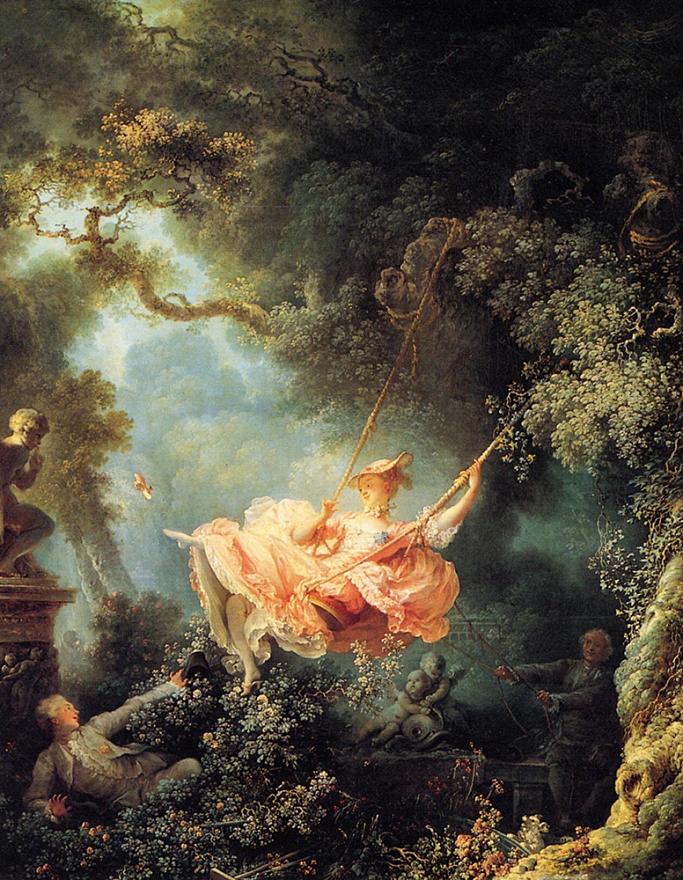Something that's been nagging at me lately has been a few posts that I've bumped into around the internet about how Lolita is absolutely not related to the French Rococo era, usually blaming Momoko Ryugasaki of Kamikaze Girls for the mix-up and following up by saying that Lolita has almost no resemblance to Rococo style, particularly early examples of the fashion.
 |
| Pardonnez? |
I'm going to state that I respectfully, but absolutely, disagree with that argument.
I also want to say that this isn't a call-out post or anything-- it's just something that I enjoy talking about, and I'm glad I was able to get this out on my birthday! This is a topic that I've researched and given presentations on copiously over the years. Let's start from the top.
What Does Rococo Even Mean?
 |
| A Rococo-era mirror; note the shell-like ridges and look closely at the "leafy" bits-- they're very reminiscent of waves! |
Of course, every style or art movement can be described as a revolution against what came before; Specifically, Rococo was a push back against the more popular Baroque period, which was dark, austere, and very much funded by the Church (which is why most of the non-portraiture artwork from the time depicts Biblical figures and scenes).
 |
| Blind Man's Bluff by Jean-Honoré Fragonard |
Style Icons of the Eighteenth Century
Absolutely everyone knows that "Rococo" is basically synonymous with the name "Marie Antoinette," the last Queen of France before the first Revolution. But there are two other people that you should really also know when it comes to this subject: the Marquise de Pompadour and Rose Bertin.
 |
| The Marquise |
Another person whom it would be foolish to overlook is Marie Antoinette's personal clothing designer, Madame Rose Bertin. Everything about her business was huge-- the coifs, the dresses, and, of course, the price tag. As synonymous of "excess" as Marie Antoinette was, Bertin understood that fashion was the chief vehicle of expression for ladies of the French court. This was why her wigs and poufs were stacked three feet high, and the panniers were massive. A court lady was no longer just decoration, but took up space and could make a statement that would be heard.
Some Bertin creations
Of course, I have to round this out by discussing the lady herself: Marie Antoinette. The less-than-nice nickname "Madame Defecit" should tell you everything you need to know about how much money she would pour into clothes, jewelry, parties, and the like. It's often theorized that the early years of her marriage, which weren't spectacular by any means, contributed heavily to her heavy spending. She needed an outlet, and found it in fashion.
 Rose Bertin was one of her worst enablers, and together they popularized what is now thought of as Rococo fashion to the general populace. It's true that Marie Antoinette eventually moved away from her "obvious" extravagance in favor of something simpler and more rural, though it was a lifestyle choice that would still cost her plenty of money and what little remained of her reputation. None of that stopped her from being the woman who brought Rococo to its peak, and its end.
Rose Bertin was one of her worst enablers, and together they popularized what is now thought of as Rococo fashion to the general populace. It's true that Marie Antoinette eventually moved away from her "obvious" extravagance in favor of something simpler and more rural, though it was a lifestyle choice that would still cost her plenty of money and what little remained of her reputation. None of that stopped her from being the woman who brought Rococo to its peak, and its end.
So What Does This Have to Do With Lolita Fashion?
A lot, really. It's easy to brush off the more overt Rococo styles to Hime Gyaru overlap, but it's important to note that the two styles developed around the same time, both achieving popularity among the Japanese street fashions in the early 2000s. Of course there was bound to be crossing of the streams, and that's not a bad thing!
Hime Gyaru takes far more inspiration from Rococo than Lolita does, and is probably responsible for most of the Rococo elements you'll find. But that's not to say that you can't see bits of my favorite French period in early examples of Lolita, too, especially the early 00s.
I'm going to more fully bring this back around to Lolita in the next installment, which might be sometime net week. For now, I hope you enjoyed this very brief discussion about the history of Rococo fashion! Thank you very much for sticking with me through the long post: here, have a bunch of pretty Rococo paintings!
 |
| Watteau's The Swing -- why this made it into a Disney children's film, I will never understand, and will always giggle at. |
 |
| The Stolen Kiss by Fragonard -- I really like his work, if you can't tell. |
 |
| Another Fragonard: Confession of Love |


I wish you would’ve explained more on the relation between rococo and lolita at the end but other than that, luved this blog entry ! super informative and interesting tyy !!
ReplyDelete